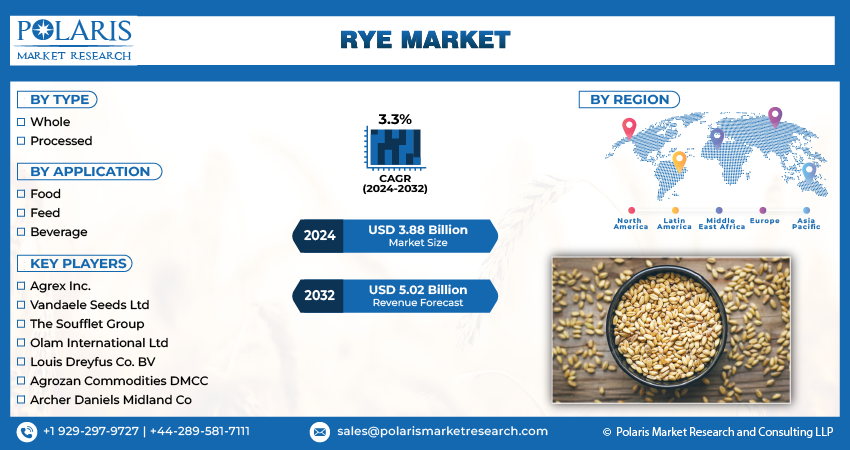
Rye Market Share, Size, Trends, Industry Analysis Report, By Type (Whole, Processed), By Application (Food, Feed, Beverage), By Region, And Segment Forecasts, 2024 - 2032
- Published Date:Jan-2024
- Pages: 118
- Format: PDF
- Report ID: PM4202
- Base Year: 2023
- Historical Data: 2019-2022
Report Outlook
The global rye market was valued at USD 3.76 billion in 2023 and is expected to grow at a CAGR of 3.3% during the forecast period.
Growth is driven by the increasing demand for rye due to its commendable nutritional profile. Rye is recognized as a rich source of essential nutrients, including vitamin B6, thiamine, iron, folate, & riboflavin, along with traces of Zn, pantothenic acid, Mg, Ca, and other micronutrients. This nutrient density contributes to various health benefits associated with rye consumption, such as promoting heart health, regulating blood sugar levels, supporting digestive well-being, and mitigating inflammation.

To Understand More About this Research: Request a Free Sample Report
Advancements in food processing technology play a crucial role in meeting the growing demand for high-quality rye products. One notable example is the application of heat treatment methods by various companies to modify the pasting properties of rye flours. This modification enhances the baking quality of products that rely on rye as a key ingredient. Furthermore, enzymes such as xylanase and transglutaminase are being strategically employed to improve the rheological properties of rye dough. This enzymatic intervention contributes to better bread quality, addressing specific challenges associated with the unique characteristics of rye in the baking process. These technological advancements underscore the industry's commitment to optimizing the production processes and elevating the overall quality of rye-based food offerings.
Moreover, there is a growing inclination among both consumers and industries to support agricultural practices that mitigate greenhouse gas emissions and enhance carbon sequestration. A noteworthy example occurred in April 2022 when research conducted at the University of Alberta underscored the substantial environmental benefits associated with certain perennial grains, including rye. In comparison to annual crops, this study demonstrated that perennial rye has the capacity to absorb a significant amount of carbon dioxide (CO2). These findings build upon prior research emphasizing the advantages of incorporating perennial crops into farming practices. As a result, the insights from these studies are likely to stimulate increased demand for perennial rye as a valuable crop in sustainable agriculture.

Industry Dynamics
Growth Drivers
Food Industry Demand
Food industry is experiencing noteworthy investments in research and development to unlock the versatility of rye as a key ingredient. Ongoing efforts by researchers focus on creating innovative rye-based products that boast higher fiber content and elevated levels of bioactive compounds. The objective is to strike a balance between enhancing the nutritional advantages of rye and ensuring that the final products meet the high standards of quality and taste expected by consumers. This drive for innovation underscores the industry's commitment to offering healthier and more appealing food options to meet evolving consumer preferences.
Report Segmentation
The market is primarily segmented based on type, application, and region.
|
By Type |
By Application |
By Region |
|
|
|
To Understand the Scope of this Report: Speak to Analyst
By Type Analysis
Whole rye segment accounted for the largest market share in 2023
Whole rye segment accounted for the largest share. The increased demand for whole-grain rye is a result of the growing awareness of the health benefits associated with whole grains. Whole rye stands out for its nutritional value, encompassing the entire grain kernel, including the bran, germ, and endosperm. This comprehensive composition retains essential nutrients like dietary fiber, vitamins, minerals, and antioxidants. In response to a heightened focus on health, consumers actively seek foods that offer these nutritional advantages. Notably, the fiber content in whole rye plays a significant role in supporting digestive health, regulating blood sugar levels, and aiding in weight management.
Processed segment will grow rapidly. Malted rye is commonly employed in brewing and distilling, particularly to produce rye whiskey and specific beer styles. The malting process plays a crucial role in enhancing the fermentability of rye by utilizing enzymes generated during germination to convert starches into fermentable sugars. This conversion is vital for the fermentation process, where yeast consumes these sugars to produce alcohol and various flavor compounds. Consumers are increasingly inclined to explore diverse flavors and styles in their beverages, driving the demand for unique ingredients like malted rye, known for imparting spicy, fruity, and grainy notes to beverages.
To meet the demand for distinctive beverages, numerous companies are introducing diverse offerings. In September 2023, Basil Hayden, unveiled a new rye whiskey crafted from malted rye. The whiskey, characterized by its light amber hue and floral aroma, delivers a palate of toasted rye, vanilla, and warm spice notes.
By Application Analysis
Beverage segment held the significant market share in 2023
Beverage segment held the significant market share. The growing embrace of plant-based diets and the increasing trend towards plant-centric lifestyles have led to a significant rise in the demand for dairy alternatives. In response to this trend, food manufacturers and innovators are actively exploring diverse plant-based ingredients to create alternatives to traditional dairy products. For instance, in July 2022, Danone, introduced Alpo Totally Nordic Rye, a plant-based milk alternative crafted from rye grain. This product launch was specifically rolled out in Finland and Sweden.
Food segment is expected to gain substantial growth rate. The consumption of food products based on rye has been linked to enhanced satisfaction and potential health advantages, such as the regulation of blood lipid levels and reduction of inflammation. Moreover, recent years have seen substantial research endeavors to create innovative food items incorporating rye. Rye's adaptability enables its use in various food products, ranging from bread, crackers, pasta, cereals to snacks. This versatility allows food companies to integrate rye into both staple and specialty foods, meeting the preferences of a diverse consumer base.

Regional Insights
Europe region dominated the global market in 2023
Europe region dominated the global market. Rye holds a significant place in the culinary traditions of numerous European countries, including Germany, Scandinavia, & the Baltic states. It is a staple ingredient in the creation of traditional bread and baked goods by artisanal and traditional bakeries, catering to consumers seeking authentic and local flavors. To meet evolving consumer preferences, food manufacturers and processors in Europe have embarked on developing novel rye-based products, such as crisps, flakes, beverages, and snacks. These innovative offerings have broadened the spectrum of rye products available, appealing to consumers who value diversity in their food choices.
The Asia Pacific will grow with substantial pace. A significant driver behind this growth is the increasing awareness of gluten sensitivities and celiac disease among consumers in the region. As more individuals become conscious of their dietary needs and preferences, there is a rising demand for alternatives to traditional wheat-based products, and rye, being a gluten-containing grain with lower gluten levels than wheat, fits the bill.
Moreover, the bakery and food industry in the region is adapting to these changing consumer preferences. There is a notable trend in using rye flour and incorporating rye-based products in the creation of a diverse range of baked goods. These include items such as bread, pastries, and crackers, aligning with the evolving tastes and preferences of consumers in the region. This shift in the culinary landscape reflects a broader global movement towards diversified and health-conscious food choices, with rye emerging as a versatile and sought-after ingredient.

Key Market Players & Competitive Insights
The rye market on a global scale exhibits a moderate level of innovation. Numerous participants in the rye industry are engaged in developing rye varieties that demonstrate enhanced resistance to diseases. Additionally, there is a trend toward the adoption of precision farming practices to optimize the cultivation of rye.
Some of the major players operating in the global market include:
- Agrex Inc.
- Vandaele Seeds Ltd
- The Soufflet Group
- Olam International Ltd
- Louis Dreyfus Co. BV
- Agrozan Commodities DMCC
- Archer Daniels Midland Co
Recent Developments
- In August 2023, The Hemingway Whiskey Company, revealed the introduction of the Hemingway Rye Whiskey Signature Edition. This whiskey offers a harmonious blend of sweet and spicy flavors, accompanied by hints of dried fruits, nuts, cocoa, and citrus zest.
Rye Market Report Scope
|
Report Attributes |
Details |
|
Market size value in 2024 |
USD 3.88 billion |
|
Revenue forecast in 2032 |
USD 5.02 billion |
|
CAGR |
3.3% from 2024 – 2032 |
|
Base year |
2023 |
|
Historical data |
2019 – 2022 |
|
Forecast period |
2024 – 2032 |
|
Quantitative units |
Revenue in USD million/billion and CAGR from 2024 to 2032 |
|
Segments covered |
By Type, By Application, By Region |
|
Regional scope |
North America, Europe, Asia Pacific, Latin America; Middle East & Africa |
|
Customization |
Report customization as per your requirements with respect to countries, region and segmentation. |
Explore the market dynamics of the 2024 Rye Market share, size, and revenue growth rate, meticulously examined in the insightful reports crafted by Polaris Market Rersearch Industry Reports. The analysis of Garbage Truck Bodies Market extends to a comprehensive market forecast up to 2032, coupled with a retrospective examination. Avail yourself of a complimentary PDF download to sample this in-depth industry analysis.
Browse for Our Top Selling Reports
Temperature Sensors Market Size & Share
Field Programmable Gate Array (FPGA) Market Size & Share
Infectious Disease Diagnostics Market Size & Share
FAQ's
Type, application, and region are the key segments in the Rye Market.
The global rye market size is expected to reach USD 5.02 billion by 2032
The global rye market is expected to grow at a CAGR of 3.3% during the forecast period.
Europe regions is leading the global market.
Increased awareness of the health benefits of whole grains are the key driving factors in Rye Market.
